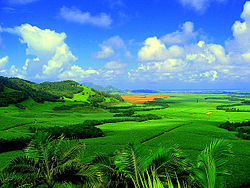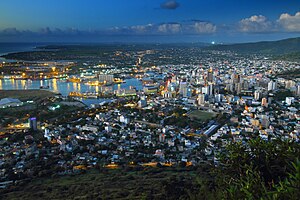History
Main article: History of Mauritius
The island of Mauritius was unknown and uninhabited before its first recorded visit during the Middle Ages by Arab sailors, who named it Dina Arobi. In 1507 Portuguese sailors visited the uninhabited island and established a visiting base. Diogo Fernandes Pereira,
a Portuguese navigator, was the first European to land in Mauritius. He
named the island 'Ilha do Cirne'. The Portuguese did not stay long as
they were not interested in these islands.[9]In 1598 a Dutch squadron under Admiral Wybrand Van Warwyck landed at Grand Port and named the island "Mauritius" after Prince Maurice van Nassau of the Dutch Republic, the ruler of his country. The Dutch established a small colony on the island in 1638, from which they exploited ebony trees and introduced sugar cane, domestic animals and deer. It was from here that Dutch navigator Abel Tasman set out to discover the western part of Australia. The first Dutch settlement lasted only twenty years. Several attempts were made —subsequently, but the settlements never developed enough to produce dividends and the Dutch abandoned Mauritius in 1710.[9][10]

The Battle of Grand Port, 20–27 August 1810.
From 1767 to 1810, except for a brief period during the French Revolution when the inhabitants set up a government virtually independent of France, the island was controlled by officials appointed by the French Government. Jacques-Henri Bernardin de Saint-Pierre visited the island and wrote Paul et Virginie, a successful novel situated on the island. In particular Charles Mathieu Isidore Decaen, a successful General in the French Revolutionary Wars and, in some ways, a rival of Napoléon I, ruled as Governor of Isle de France and Réunion from 1803 to 1810. British naval cartographer and explorer Matthew Flinders was arrested and detained by the General Decaen on the island, in contravention of an order from Napoléon. During the Napoleonic Wars, Mauritius became a base from which French corsairs organised successful raids on British commercial ships. The raids continued until 1810, when a Royal Navy expedition led by Commodore Josias Rowley, R.N., an Anglo-Irish aristocrat, was sent to capture the island. Despite winning the Battle of Grand Port, the only French naval victory over the British during these wars, the French surrendered to a British invasion at Cap Malheureux three months later. They formally surrendered on 3 December 1810, on terms allowing settlers to keep their land and property and to use the French language and law of France in criminal and civil matters. Under British rule, the island's name reverted to Mauritius.[9]

Champ de Mars, Port Louis, 1880.
At the outbreak of World War II in 1939, many Mauritians volunteered to serve under the British flag in Africa and the Near East, fighting against the German and Italian armies. Some went to England to become pilots and ground staff in the RAF. Mauritius was never really threatened, but several British ships were sunk outside Port-Louis by German submarines in 1943.
The first general elections were held on 9 August 1948 and were won by the Labour Party. This party, led by Guy Rozemont, bettered its position in 1953, and, on the strength of the election results, demanded universal suffrage. Constitutional conferences were held in London in 1955 and 1957, and the ministerial system was introduced. Voting took place for the first time on the basis of universal adult suffrage on 9 March 1959. The general election was again won by the Labour Party, led this time by Sir Seewoosagur Ramgoolam. A Constitutional Review Conference was held in London in 1961 and a programme of further constitutional advance was established. Two eminent British academics, Richard Titmuss and James Meade, published a report which dwelt upon the social problems caused by overpopulation and the monoculture of sugar cane. This led to an intense campaign to halt the population explosion, and the 1960s registered a sharp decline in population growth.
In 1965, the Chagos Archipelago was split from the territory of Mauritius to form British Indian Ocean Territory. A General election took place on 7 August 1967, and the Labour Party and its two allies obtained the majority of seats. Mauritius adopted a new constitution, independence was proclaimed on 12 March 1968, and the country became a member of the Commonwealth realm. Sir Seewoosagur Ramgoolam became the first prime minister of Mauritius. In 1969, the opposition party Mauritian Militant Movement (MMM) led by Paul Berenger was founded. Later in 1971, the MMM, backed by unions, called a series of strikes in the port which caused a state of emergency in the country, and the leader was imprisoned.[11]
Mauritius was proclaimed a republic within the Commonwealth twenty four years after independence on 12 March 1992.[9]
Politics
Geography
Main articles: Geography of Mauritius and Outer islands of Mauritius
 See also Maps of Mauritius at Wikimedia Commons
See also Maps of Mauritius at Wikimedia Commons
The island of Mauritius is relatively young geologically, having been created by volcanic activity some 8 million years ago. Together with Saint Brandon, Réunion and Rodrigues, the island is part of the Mascarene Islands. These islands have emerged from the abysses as a result of gigantic underwater volcanic eruptions that happened thousands of kilometres to the east of the continental block made up by Africa and Madagascar. They are no longer volcanically active and the hotspot now rests under Réunion island. There has been no active volcano on Mauritius island for more than 100,000 years. Mauritius is encircled by a broken ring of mountain ranges, varying in height from 300 meters to 800 meters above sea level. The land rises from coastal plains to a central plateau where it reaches a height of 670 meters, the highest peak is in the southwest, Piton de la Petite Rivière Noire at 828 metres (2,717 ft). Streams and rivers speckle the island, a lot of them are formed in the cracks created by lava flows.[24]
The island of Mauritius is situated some 2,000 kilometres (1242 miles) off the south east coast of the African continent, between Latitudes 19°58.8' and 20°31.7' South and Longitudes 57°18.0' and 57°46.5' East, it is 65 km long and 45 km wide, its land area is 1,864.8 km2.[25][26] Mauritius is surrounded by more than 150 kilometres (93 miles) of white sandy beaches and the lagoons are protected from the open sea by the world's third largest coral reef, which surrounds the island.[27] Just off the Mauritian coast lie some 49 uninhabited islands and islets (see Islets of Mauritius), some of them are used as natural reserves for the protection of endangered species.
Mauritius sought to regain sovereignty over the Chagos Archipelago situated 1287 km to the north east (see Chagos Archipelago sovereignty dispute). The Government of the Republic of Mauritius does not recognise the British Indian Ocean Territory, which the United Kingdom created by excising the Chagos Archipelago from the territory of Mauritius prior to its independence. Mauritius claims that the Chagos Archipelago, including Diego Garcia, forms an integral part of the territory of Mauritius under both Mauritian law and international law.[28] Starting in the 1960s, the islands 2,000 residents were gradually removed as a process of enabling the United States to establish a military base on the island. The Chagossians has since engaged in activism to return to the archipelago, claiming that the forced expulsion and dispossession was illegal.[7][29]
Environment

The tropical beach at Trou-aux-Biches.
Main article: Climate of Mauritius
The environment in Mauritius is typically tropical in the coastal
regions with forests in the mountainous areas. Seasonal cyclones are
destructive to the flora and fauna, although they recover quickly.
Mauritius ranked second in an air quality index released by the World Health Organization in 2011.[30][31]Situated near the tropic of Capricorn, Mauritius has a tropical climate. There are 2 seasons: a warm humid summer from November to April, with a mean temperature of 24.7° and a relatively cool dry winter from June to September with a mean temperature of 20.4°. The temperature difference between the seasons is only 4.3°. The warmest months are January and February with average day maximum temperature reaching 29.2° and the coolest months are July and August when average night minimum temperatures drops down to 16.4°. Annual rainfall ranges from 900 mm on the coast to 1,500 mm on the central plateau. Although there is no marked rainy season, most of the rainfall occurs in summer months. Sea temperature in the lagoon varies from 22° to 27°. The central plateau is much cooler than the surrounding coastal areas and can experience as much as double the rainfall. The prevailing trade winds keep the East side of the island cooler and also tends to bring more rain. There can also be a marked difference in temperature and rainfall from one side of the island to the other. Occasional tropical cyclones generally occurs between January to March and tend to disrupt the weather for only about three days bringing a lot of rain.[32]
Economy

Sugarcane plantation.
Main articles: Economy of Mauritius and Mauritian rupee
Since independence in 1968, Mauritius has developed from a
low-income, agriculture-based economy to a middle-income diversified
economy. The economy is based on tourism,
textiles, sugar, and financial services. In recent years, information
and communication technology, seafood, hospitality and property
development, healthcare, renewable energy, and education and training have emerged as important sectors, attracting substantial investment from both local and foreign investors.[20] Mauritius has no exploitable natural resources
and therefore depends on imported petroleum products to meet most of
its energy requirements. Local and renewable energy sources are biomass,
hydro, solar and wind energy.[43][44] Mauritius has one of the largest Exclusive Economic Zones in the world, in 2012 the government announced its intention to develop the Ocean Economy.[45]
Artist's impression of the Neotown development in Port Louis.

Port Louis, the capital city.
Tourism
Main article: Tourism in Mauritius
See also: Hotels in Mauritius
Mauritius is one of the world's top luxury tourism destinations.[50]
It possesses a wide range of natural and man-made attractions, enjoys a
sub-tropical climate with clear warm sea waters, attractive beaches,
tropical fauna and flora complemented by a multi-ethnic and cultural
population that is friendly and welcoming. These tourism assets are its
main strength, especially since they are backed up by well-designed and
run hotels, and reliable and operational services and infrastructures.[51]
Mauritius received the World Leading island Destination award for the
third time and World's Best Beach at the World Travel Awards in January
2012.[52] Mauritius has also one of the highest rates of returning tourism visitors in the world.[50]Transportation
Main article: Transport in Mauritius
Transport in Mauritius has been free for students, the disabled and
seniors since July 2005. There are currently no railways in Mauritius,
there were previously industrial railways, but these have been
abandoned. To cope with increasing road traffic congestion, a Light Rail
Transit system has been proposed between Curepipe
and Port Louis. The main harbour where international trade is handled
and Cruise Terminal is found at Port Louis. The main airport is Sir Seewoosagur Ramgoolam International Airport, the home of the national airline Air Mauritius, a new passenger terminal is currently under construction and will be operational in April 2013.

No comments:
Post a Comment